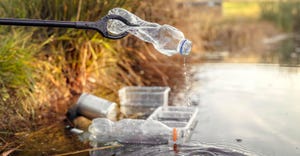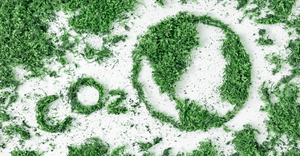GE Renewable Energy Announces US Blade Recycling Contract with Veolia
December 10, 2020
Schenectady, NY, and Boston, MA - GE Renewable Energy announced today that it has signed a multi-year agreement with Veolia North America (VNA) to recycle blades removed from its US-based onshore turbines during upgrades and repowering efforts. Through this agreement, GE plans to recycle the majority of blades that are replaced during repowering efforts.
Veolia will process the blades for use as a raw material for cement, utilizing a cement kiln co-processing technology. VNA has a successful history of supplying repurposed engineered materials to the cement industry. Similar recycling processes in Europe have been proven to be effective at a commercial scale.
As a part of the agreement, blades that have been removed from turbines will be shredded at VNA’s processing facility in Missouri and then used as a replacement for coal, sand and clay at cement manufacturing facilities across the US. On average, nearly 90% of the blade material, by weight, will be reused as a repurposed engineered material for cement production. More than 65% of the blade weight replaces raw materials that would otherwise be added to the kiln to create the cement, and about 28% of the blade weight provides energy for the chemical reaction that takes place in the kiln.
Anne McEntee, CEO of GE Renewable Energy’s Digital Services business, said “Sustainable disposal of composites such as wind turbine blades has been a challenge, not only for the wind turbine industry, but also for aerospace, maritime, automotive and construction industries. VNA’s unique offering provides the opportunity to scale up and deploy quickly in North America, with minimum disruption to customers and significant benefit to the environment. We look forward to working with them on this effort to create a circular economy for composite materials.”
Wind turbine blades may be replaced through turbine improvement or ‘repowering’ efforts, when specific elements of the turbine are upgraded to improve the efficiency and lifespan of the turbine, without replacing the entire machine. Longer, lighter blades help the turbine to generate more energy every year, providing even more renewable energy to their end customers.
Bob Cappadona, COO for VNA’s Environmental Solutions and Services division, said “By adding wind turbine blades — which are primarily made of fiberglass — to replace raw materials for cement manufacturing, we are reducing the amount of coal, sand and minerals that are needed to produce the cement, ultimately resulting in greener cement that can be used for a variety of products. Last summer we completed a trial using a GE blade, and we were very happy with the results. This fall we have processed more than 100 blades so far, and our customers have been very pleased with the product. Wind turbine blade repurposing is another example of Veolia’s commitment to a circular economy and ecological transformation in which sustainability and economic growth go hand in hand.”
VNA employs 20 people from the area at the Missouri processing facility, which is located about 70 miles northwest of St. Louis.
An environmental impact analysis conducted by Quantis U.S. found that the net effect of blade recycling through cement kiln co-processing is positive in all categories. Compared to traditional cement manufacturing, blade recycling enables a 27% net reduction in CO2 emissions from cement production and a 13% net reduced water consumption. In addition, a single wind turbine blade that weighs 7 US tons recycled through this process enables the cement kiln to avoid consuming nearly 5 tons of coal, 2.7 tons of silica, 1.9 tons of limestone, and nearly a ton of additional mineral-based raw materials. Largely due to the avoided coal consumption, this type of blade recycling also has a net-positive environmental impact in the categories of human health, ecosystem quality, and resource consumption. The resulting cement has the same properties and performance as cement manufactured using traditional means, meeting all applicable ASTM standards.
Recycling decommissioned wind turbine blades into cement production will aid the cement industry in its efforts to decarbonize. Likewise, GE Renewable Energy is committed to reducing environmental impacts throughout the life cycle of its products, including by announcing an ambitious pledge in 2019 to decarbonize its operations and achieve carbon neutrality by the end of 2020. GE Renewable Energy’s businesses are regularly partnering up with other leaders across the value chain to drive innovation for improved sustainability.
###
About GE Renewable Energy
GE Renewable Energy is a $15 billion business which combines one of the broadest portfolios in the renewable energy industry to provide end-to-end solutions for our customers demanding reliable and affordable green power. Combining onshore and offshore wind, blades, hydro, storage, utility-scale solar, and grid solutions as well as hybrid renewables and digital services offerings, GE Renewable Energy has installed more than 400+ gigawatts of clean renewable energy and equipped more than 90 percent of utilities worldwide with its grid solutions. With more than 40,000 employees present in more than 80 countries, GE Renewable Energy creates value for customers seeking to power the world with affordable, reliable and sustainable green electrons.
Follow us at www.ge.com/renewableenergy, on www.linkedin.com/company/gerenewableenergy, or on twitter.com/GErenewables
About Veolia
Veolia group is the global leader in optimized resource management. With nearly 179,000 employees worldwide, the Group designs and provides water, waste and energy management solutions which contribute to the sustainable development of communities and industries. Through its three complementary business activities, Veolia helps to develop access to resources, preserve available resources, and to replenish them.
In 2019, the Veolia group supplied 98 million people with drinking water and 67 million people with wastewater service, produced nearly 45 million megawatt hours of energy and treated 50 million metric tons of waste. Veolia Environnement (listed on Paris Euronext: VIE) recorded consolidated revenue of €27.189 billion in 2019 (USD 29.9 billion). www.veolia.com
You May Also Like


